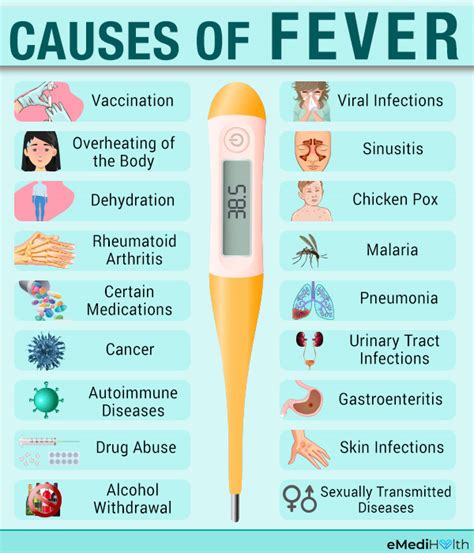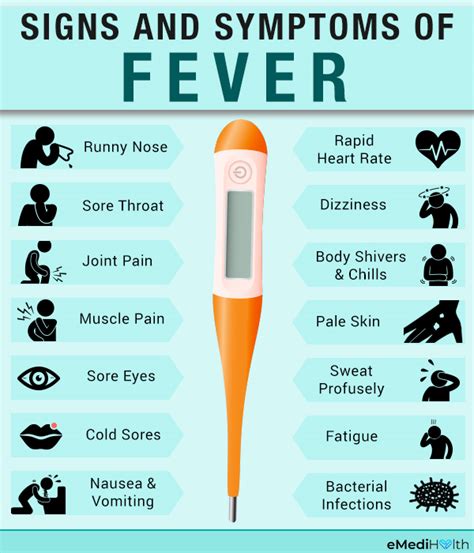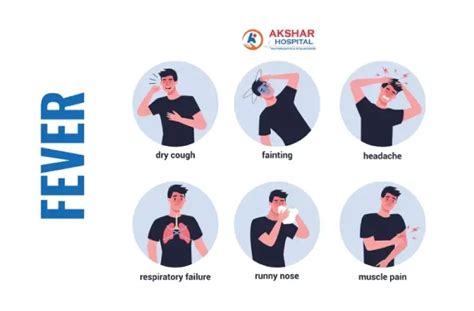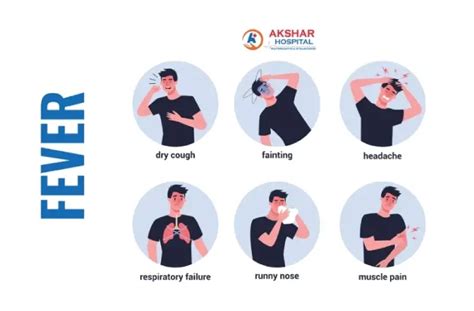Intro
Discover what causes the fever, its symptoms, and treatments. Learn about fever types, including viral and bacterial fevers, and understand how to manage fever naturally with home remedies and medication, relieving discomfort and promoting recovery.
The fever is a common symptom that affects people of all ages, and it's essential to understand what it is, its causes, and how to manage it. A fever, also known as pyrexia, is a temporary increase in body temperature, usually above 98.6°F (37°C). It's a natural response of the immune system to an infection or inflammation, and it plays a crucial role in helping the body fight off invading pathogens. When the body detects the presence of foreign substances, such as bacteria, viruses, or other microorganisms, it releases chemical messengers called pyrogens, which stimulate the hypothalamus, the part of the brain that regulates body temperature. The hypothalamus then sends signals to the body to increase its temperature, resulting in a fever.
Fever is a common symptom of many illnesses, including respiratory infections, such as pneumonia, bronchitis, and the common cold. It can also be caused by bacterial infections, such as tuberculosis, meningitis, and sepsis. In addition, fever can be a symptom of inflammatory conditions, such as arthritis, and autoimmune disorders, such as lupus. In some cases, fever can be a side effect of certain medications or medical treatments. It's essential to note that fever is not a disease itself, but rather a symptom of an underlying condition. Therefore, it's crucial to identify the underlying cause of the fever to provide proper treatment and management.
The importance of understanding fever cannot be overstated. Fever is a vital sign that can indicate the presence of an underlying infection or inflammation, and it can help healthcare professionals diagnose and treat the condition promptly. Furthermore, fever can have significant effects on the body, including increased heart rate, sweating, and dehydration. If left untreated, fever can lead to complications, such as seizures, brain damage, and even death. Therefore, it's essential to seek medical attention if you or someone you know is experiencing a high fever, especially if it's accompanied by other symptoms, such as headache, stiff neck, or difficulty breathing.
Causes of Fever

- Respiratory infections, such as pneumonia, bronchitis, and the common cold
- Bacterial infections, such as tuberculosis, meningitis, and sepsis
- Inflammatory conditions, such as arthritis and autoimmune disorders
- Medical treatments, such as chemotherapy and radiation therapy
- Certain medications, such as antibiotics and antihistamines
It's essential to note that fever can also be caused by non-infectious factors, such as heat stroke, sunburn, and dehydration. In some cases, fever can be a symptom of a underlying medical condition, such as cancer, HIV, or AIDS.
Types of Fever
Fever can be classified into different types, based on its duration, severity, and pattern. Some common types of fever include:- Acute fever: a short-term fever that lasts for a few days
- Chronic fever: a long-term fever that lasts for weeks or months
- Recurring fever: a fever that comes and goes over a period of time
- Remittent fever: a fever that fluctuates in severity over a period of time
- Continuous fever: a fever that remains constant over a period of time
Understanding the type of fever can help healthcare professionals diagnose and treat the underlying condition.
Symptoms of Fever

- Elevated body temperature
- Chills
- Sweating
- Headache
- Fatigue
- Muscle aches
- Joint pain
- Loss of appetite
- Nausea and vomiting
In some cases, fever can be accompanied by other symptoms, such as cough, sore throat, and difficulty breathing. It's essential to seek medical attention if you or someone you know is experiencing a high fever, especially if it's accompanied by other symptoms.
Diagnosis of Fever
Diagnosing the underlying cause of fever can be challenging, as it can be caused by a variety of factors. Healthcare professionals use a combination of physical examination, medical history, and diagnostic tests to diagnose the underlying cause of fever. Some common diagnostic tests used to diagnose fever include:- Blood tests: to check for signs of infection or inflammation
- Urine tests: to check for signs of infection or kidney damage
- Imaging tests: such as X-rays, CT scans, and MRI scans to check for signs of infection or inflammation
- Physical examination: to check for signs of infection or inflammation
It's essential to seek medical attention if you or someone you know is experiencing a high fever, especially if it's accompanied by other symptoms.
Treatment of Fever

- Medications: such as acetaminophen or ibuprofen to reduce fever and relieve symptoms
- Fluid replacement: to prevent dehydration and electrolyte imbalance
- Rest: to help the body recover from the underlying infection or inflammation
- Nutrition: to provide the body with essential nutrients and energy
In some cases, hospitalization may be necessary to treat the underlying cause of fever, especially if it's severe or life-threatening.
Home Remedies for Fever
There are several home remedies that can help reduce fever and relieve symptoms. Some common home remedies for fever include:- Staying hydrated: by drinking plenty of fluids, such as water, juice, and broth
- Resting: to help the body recover from the underlying infection or inflammation
- Using a cool compress: to help reduce fever and relieve symptoms
- Taking a warm bath: to help reduce fever and relieve symptoms
- Using over-the-counter medications: such as acetaminophen or ibuprofen to reduce fever and relieve symptoms
It's essential to note that home remedies should not be used as a substitute for medical treatment. If you or someone you know is experiencing a high fever, especially if it's accompanied by other symptoms, it's essential to seek medical attention.
Prevention of Fever

- Practicing good hygiene: such as washing hands regularly and avoiding close contact with people who are sick
- Getting vaccinated: against infectious diseases, such as flu and pneumonia
- Avoiding close contact: with people who are sick
- Staying hydrated: by drinking plenty of fluids
- Getting enough rest: to help the body recover from illness or injury
It's essential to note that prevention is key, and taking steps to prevent fever can help reduce the risk of developing complications.
Risk Factors for Fever
There are several risk factors that can increase the risk of developing fever. Some common risk factors for fever include:- Age: older adults and young children are more susceptible to fever
- Weakened immune system: people with weakened immune systems, such as those with HIV or AIDS, are more susceptible to fever
- Chronic medical conditions: people with chronic medical conditions, such as diabetes or heart disease, are more susceptible to fever
- Travel: traveling to areas where infectious diseases are common can increase the risk of developing fever
It's essential to take steps to reduce the risk of developing fever, especially if you have a weakened immune system or are at risk of developing complications.
Complications of Fever

- Dehydration: fever can cause dehydration, especially if it's severe or prolonged
- Electrolyte imbalance: fever can cause electrolyte imbalance, especially if it's severe or prolonged
- Seizures: fever can cause seizures, especially in young children
- Brain damage: fever can cause brain damage, especially if it's severe or prolonged
- Death: fever can be life-threatening, especially if it's severe or left untreated
It's essential to seek medical attention if you or someone you know is experiencing a high fever, especially if it's accompanied by other symptoms.
Long-term Effects of Fever
Fever can have long-term effects, especially if it's severe or prolonged. Some common long-term effects of fever include:- Fatigue: fever can cause fatigue, especially if it's severe or prolonged
- Muscle weakness: fever can cause muscle weakness, especially if it's severe or prolonged
- Joint pain: fever can cause joint pain, especially if it's severe or prolonged
- Neurological damage: fever can cause neurological damage, especially if it's severe or prolonged
It's essential to seek medical attention if you or someone you know is experiencing a high fever, especially if it's accompanied by other symptoms.
What is the normal body temperature?
+The normal body temperature is around 98.6°F (37°C), but it can vary slightly from person to person.
What are the common causes of fever?
+Fever can be caused by a variety of factors, including infections, inflammatory conditions, and medical treatments.
How can I reduce fever at home?
+There are several home remedies that can help reduce fever, including staying hydrated, resting, using a cool compress, and taking over-the-counter medications.
In conclusion, fever is a common symptom that affects people of all ages, and it's essential to understand what it is, its causes, and how to manage it. By taking steps to prevent fever, seeking medical attention if necessary, and using home remedies to reduce symptoms, you can help reduce the risk of developing complications and promote overall health and well-being. We encourage you to share this article with others, and to comment below with any questions or concerns you may have. By working together, we can promote a better understanding of fever and its management, and improve overall health outcomes.
